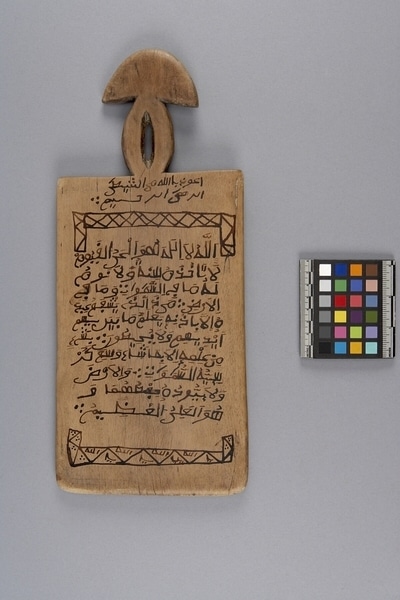Writing Tablet Item Number: K2.31 from the MOA: University of British Columbia


Description
Writing tablet, or prayer board. A flat, rectangular wood piece with an half-circle handle at the top attached by an oval with a cut-out oval hole pierced in the middle. Smooth, worn wood. Arabic script painted on both surfaces in dark brown.
History Of Use
Graduation lawh, or writing tablet. The lawh has been used for centuries throughout much of Africa to copy Quranic verses as a way to learn literacy. It is especially used in madāris (singular: madrassa), Islamic schools, for teaching the Quran to students. In many African Muslim cultures the lawh has become the main symbol of Islamic literacy and Quranic scholarship. After a student has completed the exercise of writing the entire Quran on his wooden slate, a graduation ceremony takes place. The student is given a decorated Quranic wooden tablet as a gift or certificate during this important rite of passage.
Iconographic Meaning
The writing on the front is a verse from the Qur’an, beginning with an invocation to Allah and acknowledgment of the prophet Muhammad. The writing on the back is a verse from the Qur'an, the Ayatul-Kursi (or the Throne Verse), recited for protection against evil.
Item History
- Made in Bida, Nigeria before 1969
- Collected by Michael Mason during 1969
- Owned by Michael Mason before October 20, 1970
- Received from Leon & Thea Koerner Foundation (Funding source) and Michael Mason (Seller) on October 20, 1970
What
Who
- Culture
- Nupe
- Field Collector
- Michael Mason
- Previous Owner
- Michael Mason
- Received from
- Leon & Thea Koerner Foundation (Funding source) and Michael Mason (Seller)
Where
- Holding Institution
- MOA: University of British Columbia
- Made in
- Bida, Nigeria
When
- Creation Date
- before 1969
- Collection Date
- during 1969
- Ownership Date
- before October 20, 1970
- Acquisition Date
- on October 20, 1970
Other
- Condition
- good
- Accession Number
- 0172/0008